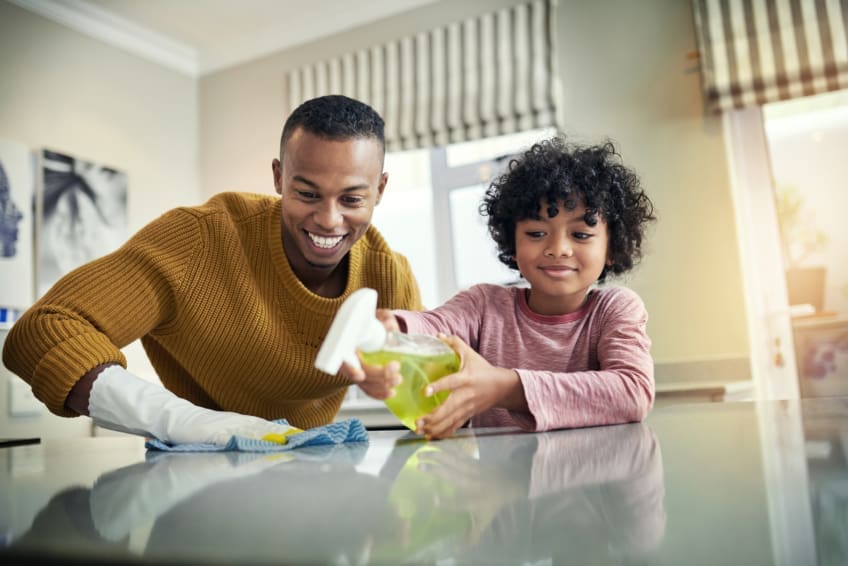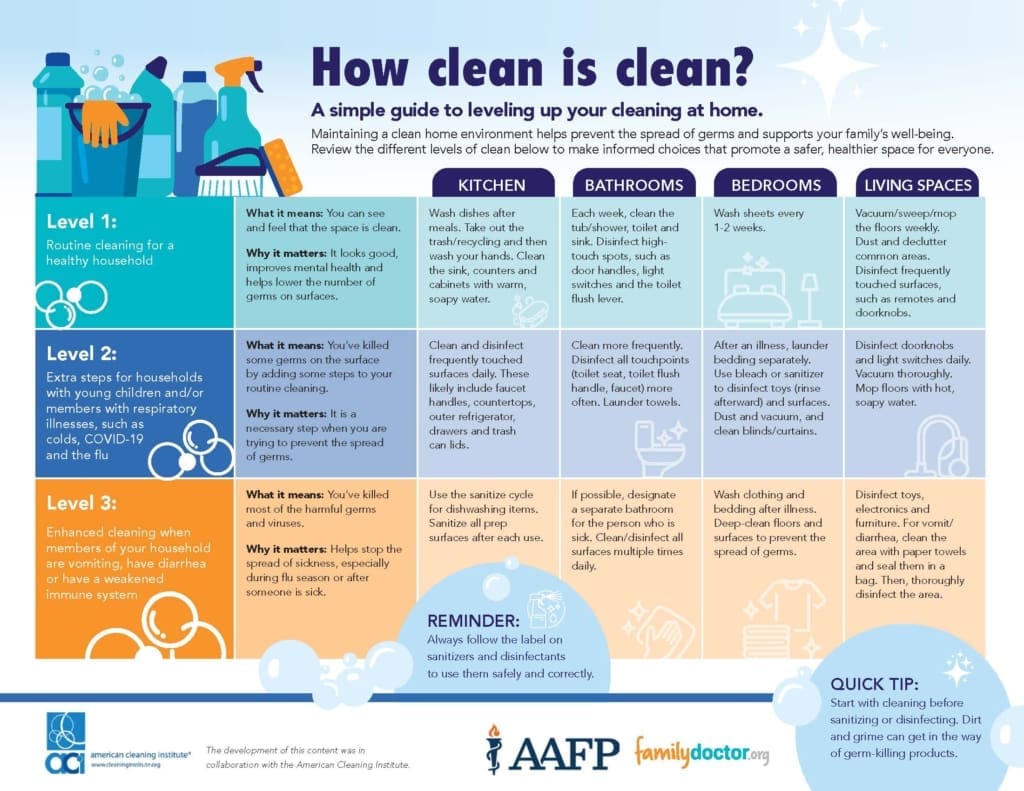
Why home disinfection and sanitization matter
Keeping your home clean does more than just make it look nice. It helps protect you and your family from getting sick. Germs can live on surfaces and spread from person to person, especially during cold and flu season.
More people are realizing that regular cleaning and disinfecting are an important part of staying healthy. In fact, a recent survey from the American Cleaning Institute (ACI) found that most Americans now clean with health in mind, not just as a chore. ACI reports that 97% of Americans believe cleaning is vital for public health, and 74% have changed cleaning habits to boost health and well-being. That’s why smart cleaning isn’t just about looking neat—it’s about staying well.

Cleaning vs. disinfecting vs. sanitizing
It’s helpful to know the difference between cleaning, sanitizing and disinfecting.
- Cleaning means getting rid of dirt, dust or food spills using soap and water. It doesn’t kill germs, but it does remove them.
- Sanitizing your home lowers the number of germs on surfaces to levels that are considered safe.
- Disinfecting your home goes even further; it kills bacteria and viruses that can cause infections.
Each one has a purpose, and together they help keep your home safer.
How to disinfect your home safely
Start by choosing the right product. Look for household disinfectants with an EPA registration number on the label. That number means the product has been tested and approved to kill certain germs. Be sure to read the instructions carefully. The label tells you how long the product needs to stay wet to work properly and what surfaces it’s safe to use on.
Before you disinfect, clean any dirty surfaces with soap and water. This helps the disinfectant do its job. Make sure the room has fresh air while you clean; open a window or turn on a fan. Some products have strong smells, and good airflow makes it safer and more comfortable. You can also wear gloves to protect your skin from strong chemicals.
Best ways to sanitize high-touch surfaces
Think about the things that get touched all the time: doorknobs, light switches, remote controls, phones and faucet handles. These areas should be cleaned and disinfected regularly. You can use disinfectant wipes or spray a disinfectant onto a clean cloth and wipe them down. Just make sure to follow the instructions on the label to get the best results.
How to clean your home room by room
The kitchen
Clean your counters, sink, and cabinet handles often. Don’t forget to wipe down appliances and take out the trash regularly. Be sure to wash your hands after taking out any trash or recyclables.
The bathroom
Clean and disinfect toilets, sinks, shower areas, and the floor at least once a week. Use disinfectant on high-touch spots, such as light switches, toilet flush handles, and faucet handles. Launder towels regularly.
The living room and bedrooms
Vacuum carpets and mop hard floors to get rid of dust and allergens. Wash bedding every one to two weeks—more often if someone has been sick. Wipe down electronics (following manufacturer instructions), windowsills and light switches in these rooms, as well.
Windows, frames and curtains can collect dust throughout time. Use a cleaning spray or wipes to clean windows and try to wash or dry clean curtains at least twice a year.
Home sanitization tips for families with children
If you have young kids, cleaning toys is especially important. For soft toys, like stuffed animals, you can put them in a pillowcase and wash them in the washing machine on a gentle cycle. Dry them on low heat. For hard plastic toys, wash them with soap and water, then disinfect them with a product that is safe for children. Let the toy dry completely, then rinse it if needed, especially if it’s something that goes in a child’s mouth. When kids share toys, make sure those toys are cleaned and disinfected between uses.
How to choose a safe household disinfectant
Not all disinfectants are the same. Check the label to find out what germs a product can kill and how long it needs to stay on a surface. Some products contain harsh chemicals, while others use gentler ingredients like hydrogen peroxide and vinegar and are fragrance-free. Pick the one that works best for your family and always store cleaners out of reach of children. Keep products in their original containers so you can read the safety directions.
Quick health and safety reminders
Make it a habit to wash your hands after cleaning, caring for someone who is sick or changing diapers. If someone in your home is ill, clean more often than usual. Open windows when you can to let in fresh air. This helps reduce the number of germs in the air. Also:
- Don’t combine cleaning agents. Many cleaning solutions can be harmful to the skin or breathing when combined. Read and follow the labels on the back of the product for safety instructions and proper use.
- Ventilate the room when cleaning, if possible. Many cleaning solutions have strong odors. Open a window or use a ceiling or room exhaust fan when cleaning.
- Consider wearing gloves when cleaning. Harsh chemicals can irritate your skin.
- Make sure all products are stored in the original container and kept out of reach and sight of children when not is use.
Cleaning isn’t just something to check off a list. It’s a way to care for your family and create a safer, healthier home. With a few simple habits and the right tools, you can help stop the spread of illness and feel better in your space.
Questions to ask your doctor
- How often do I need to wipe down surfaces?
- Do I need to use bleach-based products?
- Is winter worse than spring for illness?
- Are professional cleaning services better than do-it-yourself cleaning?
- Can my pet bring bacteria and fungi into my home?
Resources
The American Cleaning Institute: Levels of Cleaning for Better Health
American Cleaning Institute: Cleaning Is Caring
American Cleaning Institute: Clean First Steps
#CleaningforHealth #DiscoverClean #PacketsUp #StoreNotDecor
The development of this content was in collaboration with the American Cleaning Institute™.
![]()
Copyright © American Academy of Family Physicians
This information provides a general overview and may not apply to everyone. Talk to your family doctor to find out if this information applies to you and to get more information on this subject.







